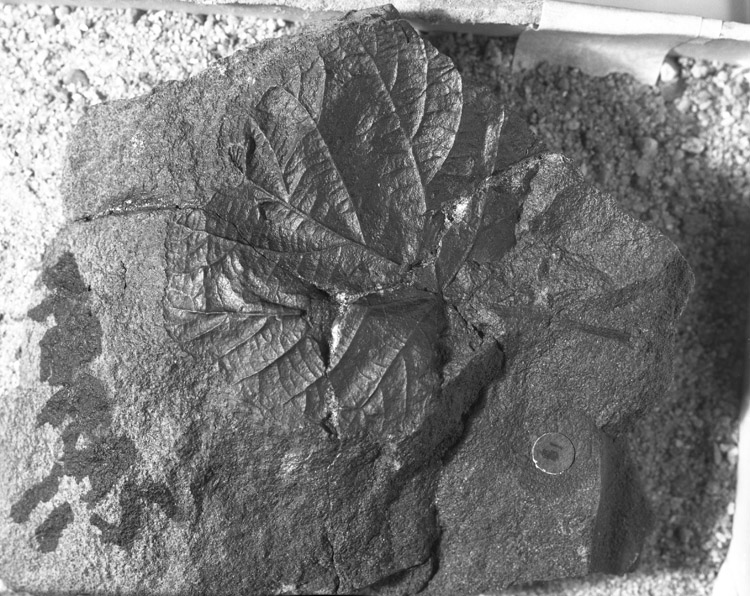Locality
Plant fossils were collected from a limy iron-rich (sideritic) indurated layer within a gray clay on the east bank of the tributary of the Jago River. This locality is equivalent to Detterman 300P.
Description
Leaf: simple; symmetrical; wide ovate; apex acute with a rounded tip; base lobate, the lobes tending to overlap below the junction of the petiole and lamina; margin crenate, teeth with rounded microscopically retuse apices and angular sinuses, glands in tooth apex often in sinus, tooth size variable but rarely more than 2 mm wide, margin apparently entire very close to the petiole; venation basal, imperfect marginal actinodromous; primary midvein more or less straight, moderate; a-pectinals departing base of midvein at 50° curved, semicraspedodromous, a-abmedials departing at 55-70°, angle increasing near margin, curved, brochidodromous and craspedodromous; b-pectinal veins arising from base at midvein at an angle of 120°, moderate, uniformly curved, curvature may become abrupt at the point of departure of the b-abmedials, b-abmedials arising at an angle of 70-75°, curved, branched, degree of curvature increasing near the margin (particularly in those veins originating close to the petiole) to form loops joining a branch of the superadjacent abmedial at approximately 90°, those abmedials originating from the b-pectinals nearer the margin have less well-developed loops partly composed of third order veins, the more basal abmedials branch abmedially to give off third order semicraspedodromous veins at angles of 55-65°; superior secondary veins arising from the primary midvein at angles of approximately 55°, moderate curved, often repeatedly branching abmedially, branches curved, craspedodromous or semicraspedodromous; tertiary veins percurrent, usually convex, sometimes straight, sinuous or even concave near the margins, often forked, arranged concentrically to the junction of the petiole with the lamina, forming various angles with both ad- and abmedial sides of secondaries with a mean of 90°; fourth order veins percurrent, sinuous or more or less straight, often forked, sometimes forming an orthogonal reticulum; fifth order veins predominantly orthogonal, areolation imperfect, randomly arranged, predominantly quadrangular of medium size and often surrounding once branched veinlets.
Remarks
These (USGS11474.1, USGS11488.1, USGS11481.5) well-preserved leaves with pronounced venation compare well with the palmate dilleniids based on the typical characters outlined in Hickey and Wolfe (1975). They all possess actinodromous venation with semicraspedodromous secondaries and tertiary veins arranged concentrically around the petiole junction with the lamina. The architecture is not always consistent between the various parts of the lamina. For instance the pectinal exmedials may be looped, semicraspedodromous or craspedodromous and glands in the sinuses of the teeth are not always present.
The teeth have glandular apices and are apparently similar to those figured as 'salicoid' in Hickey and Wolfe (1975) and in particular the example of Idesia polycarpa Maxim (Hickey and Wolfe, 1975, Fig. 16). The characteristic bracing lateral veins of Chloranthoid teeth are lacking in specimen 11488.1, although some teeth do have pronounced looping of the subsidiary veins in them. Such looping is also seen in Salicoid and to some extent Violoid teeth.
Comparison with published specimens reveals a similarity to a specimen assigned to 'Vitis' olricki Heer by Hollick (1936, p. 142; Plate 81, Fig. 2). the differences appear to be that Hollick's specimen has a less well-developed lobate base and possesses a dentate rather than a crenate margin. Berry also described a specimen from the Maastrichtian of southern Saskatchewan (Berry 1935, p. 47-48; Plate 12, Fig. 2), which is again similar but differs in having dentate or serrate teeth and which was given the name 'Vitis' dakotana Berry.
This specimen exhibits the closest similarity to Corylites beringianus (Kryshtofovich) Golovneva and thus may be the same as DIPE168.
